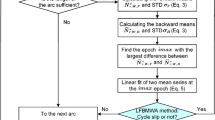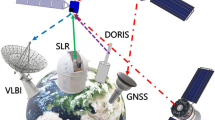Abstract
Cycle slip detection and repair are prerequisites to the use of the global navigation satellite system (GNSS) carrier phases for precise positioning. Modern GNSS techniques introduce triple- or multi-frequency signals that are beneficial for cycle slip detection and repair. We present a new real-time cycle slip detection and repair method based on the independent linear combinations of undifferenced triple-frequency GNSS observations. The proposed method forms three types of linear combinations based on the original observations. These combinations are called extra-wide lane (EWL), wide lane (WL), and narrow lane (NL). Cycle slips on the combinations are determined sequentially in three cascaded steps. The first step employs the geometry-free and ionosphere-free Hatch–Melbourne–Wübbena combination to determine and repair the EWL cycle slips. The second step subtracts the cycle-slip-repaired EWL combination from the WL combination to eliminate the geometry part of the WL combination. This subtraction results in a new function that contains the WL ambiguity and residual ionospheric delay. This function is differenced at two consecutive epochs to determine the WL cycle slips. The residual ionospheric delay difference is ignored because of its small magnitude relative to WL wavelength. The third step determines the NL cycle slips in the same manner as in the second step. The difference is that the cycle-slip-repaired EWL combination is replaced with the more accurate cycle-slip-repaired WL combination. Moreover, the residual ionospheric delay difference is compensated by the ionospheric delay rate derived from the original carrier phase observations. When the EWL, WL, and NL cycle slips are determined, cycle slips on the original carrier phase observations can be uniquely identified. The proposed approach has been tested on 30-s triple-frequency BeiDou navigation satellite system data under different levels of ionospheric variations, and on 30-s triple-frequency global positioning system and quasi-zenith satellite system data. Results indicate that the approach can effectively detect and correct cycle slips even for one cycle under low sampling rate or active ionospheric conditions on each frequency in real time.




Similar content being viewed by others
References
Banville S, Langley RB (2010) Instantaneous cycle slips correction for real time PPP applications. Navigation 57(4):325–334
Beutler G, Bock H, Brockmann E et al. (2006) BERNESE GPS software version 5.0
Bisnath SB, Langley RB (2000) Automated cycle-slip correction of dual-frequency kinematic GPS data. In: Proceedings of 47th conference of CASI, Ottawa, Canada
Blewitt G (1990) An automatic editing algorithm for GPS data. Geophys Res Lett 17(3):199–202
Cai C, Liu Z, Xia P, Dai W (2013) Cycle slip detection and repair for undifferenced GPS observations under high ionospheric activity. GPS Solut 17(2):247–260
Cao C, Jing G, Luo M (2008a) COMPASS satellite navigation system development. PNT challenges and opportunities symposium, Stanford, California, USA, 5–6 Nov 2008
Cocard M, Bourgon S, Kamali O, Collins P (2008) A systematic investigation of optimal carrier-phase combinations for modernized triple-frequency GPS. J Geod 82(9):555–564
Dai Z, Knedlik S, Loffeld O (2008) Realtime cycle slip detection and determination for multiple frequency GNSS. In: Proceedings 5th workshop on positioning, navigation and communication 2008 (WPNC’08)
Dai Z, Knedlik S, Loffeld O (2009) Instantaneous triple-frequency GPS cycle-slip detection and repair. Int J Navig Obs. Article ID407231. doi:10.1155/2009/407231
de Lacy MC, Reguzzoni M, Sanso F, Sanso F, Venuti G (2008) The Bayesian detection of discontinuities in a polynomial regression and its application to the cycle slip problem. J Geod 82(9):527–542
de Lacy MC, Reguzzoni M, Sanso` F (2012) Real-time cycle slip detection in triple-frequency GNSS. GPS Solut 16(3):353–362
Euler HJ, Goad CC (1991) On optimal filtering of GPS dual frequency observations without using orbit information. Bull Geod 65(2):130–143
Feng Y (2008) GNSS three carrier ambiguity resolution using ionosphere-reduced virtual signals. J Geod 82(12):847–862
Gao Y, Li Z (1999) Cycle slip detection and ambiguity resolution algorithms for dual-frequency GPS data processing. Mar Geod 22(4):169–181
Hatch R (1982) The Synergism of GPS Code and Carrier Measurements. In: Proceedings of the third international symposium on satellite doppler positioning at physical sciences laboratory of New Mexico State University, Feb. 8–12, vol 2, pp 1213–1231
Kim D, Langley RB (2001) Instantaneous real-time cycle-slip correction of dual frequency GPS data. In: Proceedings of the international symposium on kinematic systems in geodesy, geomatics and navigation, pp 255–264
Lichten SM, Bar-Sever YE, Bertiger EI, Heflin M, Hurst K, Muellerschoen RJ, Wu SC, Yunck TP, Zumberge JF (1995) GIPSY-OASIS II: a high precision GPS data processing system and general orbit analysis tool, technology 2006, NASA Technology Transfer Conference, Chicago, Illinois, 24–26 October 1995
Liu Z (2011) A new automated cycle slip detection and repair method for a single dual-frequency GPS receiver. J Geod 85(3):171–183. doi:10.1007/s00190-010-0426-y
Liu Z, Chen W (2009) Study of the ionospheric TEC rate in Hong Kong region and its GPS/GNSS application. In: Proceedings of the international technical meeting on GNSS global navigation satellite system—innovation and application, Beijing, China, pp 129–137
Liu J, Ge M (2003) PANDA software and its preliminary result of positioning and orbit determination. J Nat Sci Wuhan Univ 8(2B):603–609. doi:10.1007/BF02899825
Melbourne WG (1985) The case for ranging in GPS based geodetic systems. In: Proceedings of 1st international symposium on precise positioning with the global positioning system, Rockville, ML, pp 373–386
Wang G, Jong K, Zhao Q, Hu Z, Guo J (2014) Multipath analysis of code measurements for BeiDou geostationary satellites. GPS Solut 1–11. doi:10.1007/s10291-014-0374-8
Wu Y, Jin SG, Wang ZM, Liu JB (2009) Cycle slip detection using multi-frequency GPS carrier phase observations: a simulation study. Adv Space Res 46(2):144–149
Wübbena G (1985) Software developments for geodetic positioning with GPS using TI 4100 code and carrier measurements. In: Proceedings of 1st international symposium on precise positioning with the global positioning system, Rockville, ML, pp 403–412
Acknowledgments
This study has been supported by the National Natural Science Foundation of China (No: 41231174). The authors express their sincere gratitude to the anonymous reviewers for their constructive comments and suggestions to improve the quality of the paper.
Author information
Authors and Affiliations
Corresponding author
Rights and permissions
About this article
Cite this article
Zhao, Q., Sun, B., Dai, Z. et al. Real-time detection and repair of cycle slips in triple-frequency GNSS measurements. GPS Solut 19, 381–391 (2015). https://doi.org/10.1007/s10291-014-0396-2
Received:
Accepted:
Published:
Issue Date:
DOI: https://doi.org/10.1007/s10291-014-0396-2




